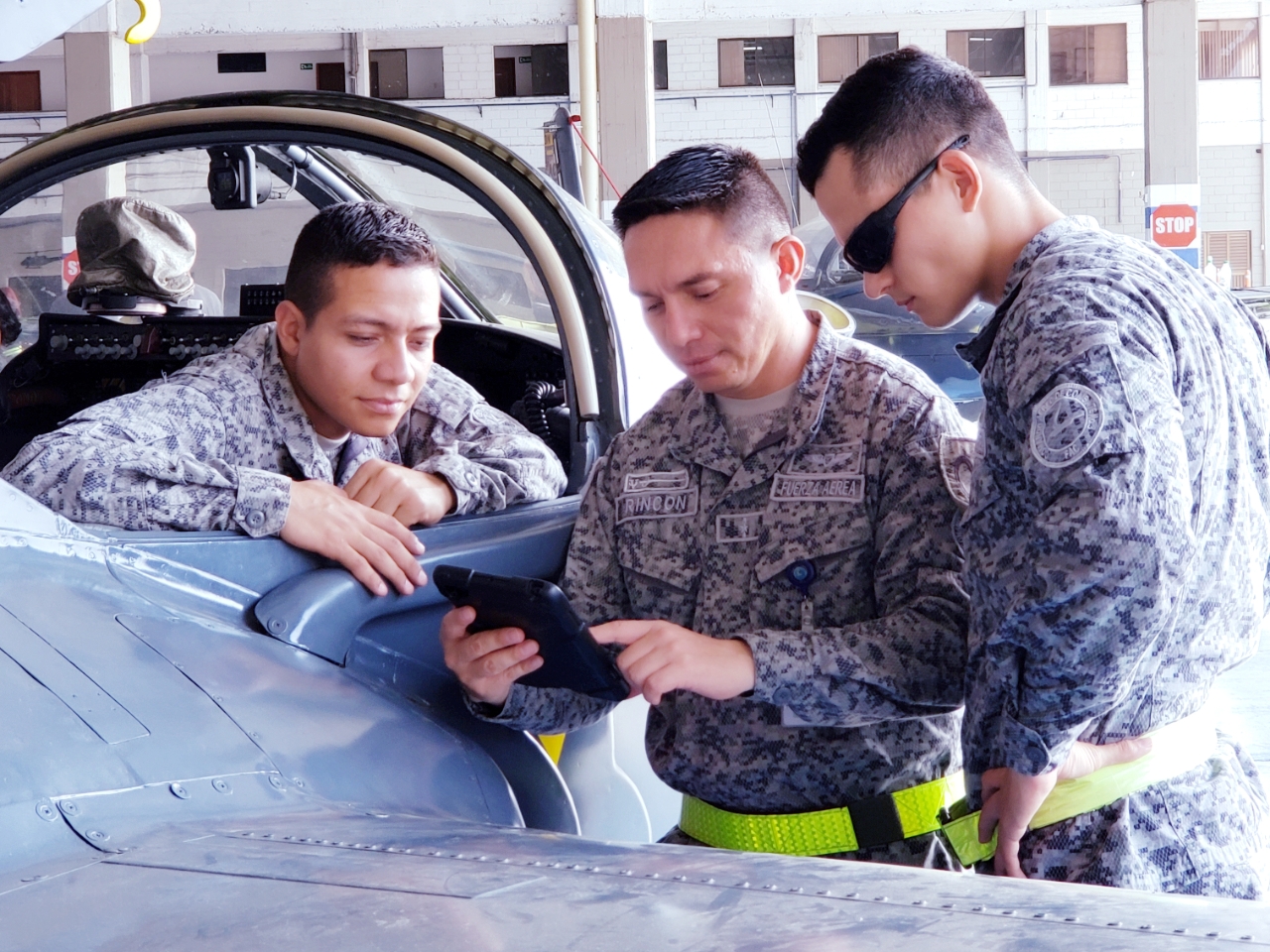Nivel de conocimiento en maintenance resource management (MRM) en el CACOM-3 de la Fuerza Área Colombiana
Barra lateral del artículo

Cómo citar
Detalles del artículo
Se solicita a los autores que diligencien el documento de cesión de derechos de autor sobre el artículo, para que sea posible su edición, publicación y distribución en cualquier medio y modalidad: medios electrónicos, CD ROM, impresos o cualquier otra forma, con fines exclusivamente científicos, educativos y culturales
- La obra pertenece a UNIMINUTO.
- Dada la naturaleza de UNIMINUTO como Institución de Educación Superior, con un modelo universitario innovador para ofrecer Educación de alta calidad, de fácil acceso, integral y flexible; para formar profesionales altamente competentes, éticamente responsables y líderes de procesos de transformación social, EL CEDENTE ha decidido ceder los derechos patrimoniales de su OBRA, que adelante se detalla para que sea explotado por ésta
- El querer de EL CEDENTE es ceder a título gratuito los derechos patrimoniales de la OBRA a UNIMINUTO con fines académicos.
Contenido principal del artículo
Resumen
El propósito de esta investigación fue determinar el nivel de conocimiento en Maintenance Resource Management (MRM), que posee actualmente el personal técnico que labora en mantenimiento de aeronaves A-37B, A-29, C-95, SR-560, C-208 y B 212 en la Fuerza Aérea Colombiana (FAC) en el Comando Aéreo de Combate No. 3 (CACOM-3), en busca de mejorar cada día más la Seguridad Operacional al interior de la Fuerza.
El procedimiento establecido para determinar el nivel de conocimiento en (MRM), consistió en diseñar un instrumento de recolección de datos en Safety Management System (SMS), Human Factors (HF) y Normatividad FAC vigente (Manual de Mantenimiento y Mensajes Técnicos [1]), como aspectos fundamentales para un entorno operacional administrado bajo la cultura de un sistema integrado de MRM en la FAC. Con esta información se estableció estadísticamente cuales son los aspectos del conocimiento más débiles en el personal de Oficiales de Mantenimiento, Inspectores, Jefes de Grupo y Operarios que labora en el proceso de mantenimiento aeronáutico bajo los mismos parámetros. Finalmente, se presentan los resultados del análisis de la información obtenida y se concluye con el nivel de conocimiento en Seguridad Operacional y Manejo de Recursos de Mantenimiento en el Comando Aéreo de Combate No. 3.
Referencias
[2] FAC-O-MASEO. (2010). Manual de Gestión en Seguridad Operacional para la Fuerza Aérea Colombiana primera edición 2010, Bogota: FAC. p 21-32.
[3] Erazo, G., y Estrada, E. (Comp.); Rodríguez, G. (Dir.); Solano, M. (Ed.). (2015). Estudios de Seguridad Operacional, una Mirada desde la Academia. Compilación de artículos de revisión sobre Seguridad Operacional. Primera edición. Colección Ciencia y Poder Aéreo No. 9. Bogotá, Colombia: Escuela de Postgrados de la Fuerza Aérea Colombiana.
[4] FAC-IGEFA. (2016). QRH Guia Rapida de Seguridad Operacional FAC. Bogota: FAC p(91).
[5] SKYBRARY. (20 de 09 de 2016). www.skybrary.aero. Obtenido de www.skybrary.aero: https://www.skybrary.aero/index.php/Human_Factors_Analysis_and_Classification_System_(HFACS)
[6] Chun-Yong Kim, B.-H. S. (2015). A Study on Safety Culture in Aviation Maintenance Organization. Gunsan, Korea: Department of Defense Science & Technology, Howon University.
[7] K.A. Pettersen, K. A. (2007). Explaining safe work practices in aviation line maintenance. Stavanger, Norway: El Seviere.
[8] Kanki, B. G. (2010). Human factors in aviation. USA: Elsevier Inc NASA.
[9] Lozano Alvernia, E. (. (2008). La seguridad en la aviación depende de los factores humanos. . Bogota: Ciencia Y Poder Aéreo, 3(1), 37-39. https://doi.org/10.18667/cienciaypoderaereo.65.
[10] Siao, D. H. (2015). THE IMPLEMENTATION OF SAFETY MANAGEMENT SYSTEMS IN MAINTENANCE OPERATIONS. Tennessee, USA : College of Basic and Applied Sciences Middle Tennessee State University.
[11] Patankar, J. C. (2001). Four generations of maintenance resource management program in the United States: and analysis of the past, present and future. Jornalist of air transportation world wide, p. 4.
[12] Robertson, M. (31 de 01 de 2005). www.faa.gov. Obtenido de www.faa.gov: https://www.faa.gov/about/initiatives/maintenance_hf/library/documents/media/human_factors_maintenance/human_factors_guide_for_aviation_maintenance_-_chapter_16.maintenance_resource_management.pdf p.2.
[13] Hernández, R. F. (2014). Metodología de la Investigación. México: Mc Graw Hill p-cap 2,3 y 4.
[14] Cordero, Z. R. (2009). LA INVESTIGACIÓN APLICADA: UNA FORMA DE CONOCER. Costa Rica: Universidad de Costa Rica.
[15] Ortega, S. (2018). Modulo 3 Metodologia de la Investigación MAESO . Bogota, DC.: Universidad EAN.
[16] Caren A. Wenner, C. G. (1998). Analyzing human error in aircraft ground damage incidents. Buffalo, USA: International Journal of Industrial Ergonomics 26 (2000) 177}199 p.179-180.
[17] D. Virovac, A. D. (2007). THE INFLUENCE OF HUMAN FACTOR IN AIRCRAFT MAINTENANCE. Zagreb, Croatia: University of Zagreb, Faculty of Transport and Traffic Sciencies p 259-261.
[18] KOZUBA, J. (2011). Impact of human factor on likelihood of aircraft accident. Dęblin, Poland: Faculty of Logistic and National Safety, Polish Air Force Academy p.31.
[19] Rashid, H. S. (210). Human Factors Effects in Helicopter Maintenance: Proactive Monitoring and Controlling Techniques. Cranfield, England: Cranfield University p. 28, 45
[20] SKYBRARY. (25 de 05 de 2016). www.skybrary.aero. Obtenido de www.skybrary.aero: https://www.skybrary.aero/index.php/ICAO_SHELL_Model
[21] SKYBRARY. (20 de 09 de 2016). www.skybrary.aero. Obtenido de www.skybrary.aero: https://www.skybrary.aero/index.php/PEAR_Model
[22] William B. Johnson, J. W. (2000). REDUCING INSTALLATION ERROR IN AIRLINE MAINTENANCE. USA: FAA.
[23] Xavier, A. J. (2005). MANAGING HUMAN FACTORS IN AIRCRAFT MAINTENANCE THROUGH A PERFORMANCE EXCELLENCE FRAMEWORK. Daytona, USA: Embry-Riddle Aeronautical University p. 14-18.
[24] ICAO. (14 de 11 de 2014). www.icao.int. Obtenido de www.icao.int: https://www.icao.int/SAM/Documents/2014-ADSAFASS/10_SMS.pdf




